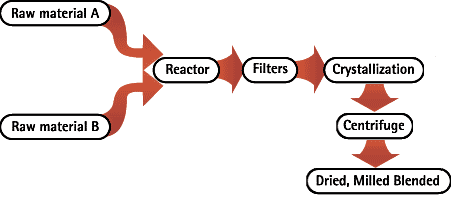This topic takes on average 55 minutes to read.
There are a number of interactive features in this resource:
 Chemistry
Chemistry
 Science
Science
The first stage of making a medicine is to manufacture the active ingredient.We call this stage the primary manufacture.The active pharmaceutical ingredient (API) will normally make up a small proportion of the final medicine. However this is the part that will treat the disease.
There are two main ways of developing the active ingredient
Developing the process to manufacture the active ingredient requires skilled chemists and chemical engineers to investigate alternative chemical reactions to find out which makes the product they want in the highest yield and purity. They also have to consider the environment. So, the solvents used will, wherever possible, be water based and energy consumption will be minimised. During research and development, the chemical reactions will have been scaled up in a pilot plant.
Primary manufacture often involves chemical reactions to create new molecules. There can be many stages to these reactions. The diagram shows a simple example in which two ingredients are reacted together.

One of the products of this reaction is the active ingredient. However, there are other products as well. The chemists need to isolate and purify the active ingredient using a variety of techniques.
In our example, the active ingredient is in a solution so the mixture can be filters to remove any unwanted residues. The active ingredient will then crystallise when the solvent is allowed to evaporate. Sometimes there will need to be more stages before a completely pure sample is produced.
Many medicines are based on active ingredients made using chemical processes. The products are generally relatively small molecules such as those used for treatment of asthma, heart disease and pain. Some antibiotics, used to treat bacterial infections, may have a biotechnology product as one of their raw materials. This is then reacted with chemicals to create the antibiotic.
Sometimes an alternative biological process can be used to make the active ingredient; this is known as biotechnology.
Biotechnology is the industrial use of biological material. This means that living materials are used in the manufacture of ingredients. Using biotechnology to make medicines started when penicillin was extracted from the mould Penicillin notatum in the 1930s, but biotechnology has been used for brewing and making cheese for hundreds of years.
More recently, scientists have modified the genes of bacteria so that they can produce useful proteins for use as medicines. By the 1980s there were bacteria making human insulin for the treatment of diabetes and also human growth hormone. This technique is called genetic engineering. You can learn more about this process in the Genes and Inheritance topic.
Genetic engineering allows scientists to introduce new genes that will make useful proteins into the DNA of cells. These cells may be bacteria, fungi, or cultures of animal cells. The modified cells can be grown on a large scale to produce large quantities of proteins. These products are known as biopharmaceuticals or biologics. They may be vaccines, hormones, enzymes or monoclonal antibodies. Monoclonal antibodies help to prevent rejection of transplants and can be used to diagnose and treat some types of cancer and can be used to treat other diseases such as arthritis.